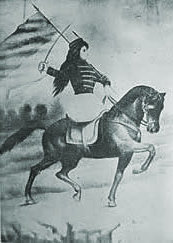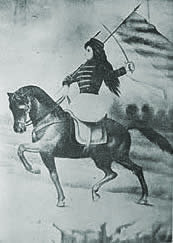
|
Women and Independence in Latin America An exploration of women's involvement in the Latin American Wars of Independence |

|

|
Women and Independence in Latin America An exploration of women's involvement in the Latin American Wars of Independence |

|
Gender:Female
Ethnic origen: White
Events:
| 1792 | - | São José de Itapororocas | - | Not applicable | - | She was born and lived here. |
| 1823 | - | Rio de Janeiro | - | Unknown | - | She visited the Emperor here. |
| 1823 | - | Bahia | - | Unknown | - | She fought in the Battle of the Recôncavo in Bahia in 1823. |
| 1823 | - | Rio de Janeiro | - | Patriot | - | She met Mary Graham |
| 1825 | - | Bahia | - | Unknown | - | Married |
| 1853 | - | Salvador | - | Unknown | - | Died August 21 1853 |
Connections:
Mary Graham, described byBiography:
Maria Quitéria was born in 1792 in São José de Itapororocas in Bahia state and died in 1853. She is thought to have been the daughter of a Portuguese named Gonçalves de Almeida and a Portuguese mother who died when Maria Quitéria was ten. She grew up reputedly enjoying the outdoors and learning to hunt, but more or less confined to a domestic existence.
This changed when the troops of Dom Pedro I, following the declaration of independence, came to Bahia recruiting soldiers to fight for the patriotic cause. Maria Quitéria’s father refused to provide any assistance to the struggle, being too old himself and with no sons to offer. His daughter therefore determined to enlist herself and, with the help of a sister who lent her husband’s clothes, she went to the town of Cachoeira disguised as a man and joined the army under her brother in law’s name, Medeiros. She fought with the infantry of the Emperor’s Volunteers against Portuguese rule, most notably in the Battle of the Recôncavo in Bahia in 1823. Her identity was revealed when her father came looking for her but this did not prevent from her remaining in the army (Vassoler, 44). Once her identity was known, she is reputed to have feminized her male military dress with the addition of a highlander’s kilt, believing it to be a skirt. Among the various battles she fought, it is believed that she led her unit when her lieutenant was killed at the Battle of Itapoã in 1823. Later that year, some commentators report that she married fellow soldier João José Luiz (Vassoler, 45-6). It is even thought that she headed a battalion of women soldiers at a battle on the banks of the Paraguaçu. She went on to so distinguish herself as a soldier that she was decorated by the Emperor personally on a visit to the palace in Rio, in addition to receiving a life stipend for her military services. Indeed she was even posthumously honoured by the Brazilian armed forces in 1996, with a further, very high, military honour (Vassoler, 39). In 1825, she married her childhood suitor Gabriel Pereira Brito, whom her father had rejected many years before. It is not known what happened to her first husband, if indeed there was one. In her later life, she had a daughter, Luísa Maria da Conceição, and settled down to a rural, farming existence back in Bahia, though she was defrauded of her share in her father’s inheritance by her stepmother (Vassoler, 49-53 ) and never won her battle to regain it. She went progressively blind in later life and died in Salvador de Bahia in 1853.
A brief reference to Maria Quitéria appears in Maria Graham’s Journal of a Voyage to Brazil, and Residence there, during Part of the Years 1821, 1822, 1823 since Graham received a visit from her in Rio in 1823. Graham raises the possibility of a different, unofficial parentage, noting that “the young woman’s features, especially her eyes and forehead, have the strongest characteristics of the Indians…” (Mavor, 164). Graham was impressed by Maria Quitéria’s lack of masculine vulgarity and was keen to assert that her virtue remained in tact throughout her military campaigns. Born in Scotland, Graham was shocked and amused to be greeted by Maria de Jesus wearing her tartan kilt over her imperial uniform and with Maria de Jesus's explanation that it was a “feminine” mode of dress. As Graham observes, “what would the Gordon’s and MacDonald’s say to this? The ‘garb of old Gaul’, chosen as a womanish attire!” (Mavor, 164). The original 1824 edition of Graham’s Journal of a Voyage to Brazil includes a picture of Maria Quitéria, complete with kilt. Ivan Vassoler indicates that this was produced by Augustus Earl, a draftsman whom Graham requested to draw a picture of Maria Quitéria in uniform (Vassoler, 52).
References:
Mavor, Elizabeth (editor). (1993) The Captain's Wife. The South American Journals of Maria Graham, 1821-23
Sabino, Ignez (1899) Mulheres Illustres do Brazil
Vassoler, Ivani (2005) A Woman on the Front-Lines Against the Last Bastion of Colonialism in Brazil